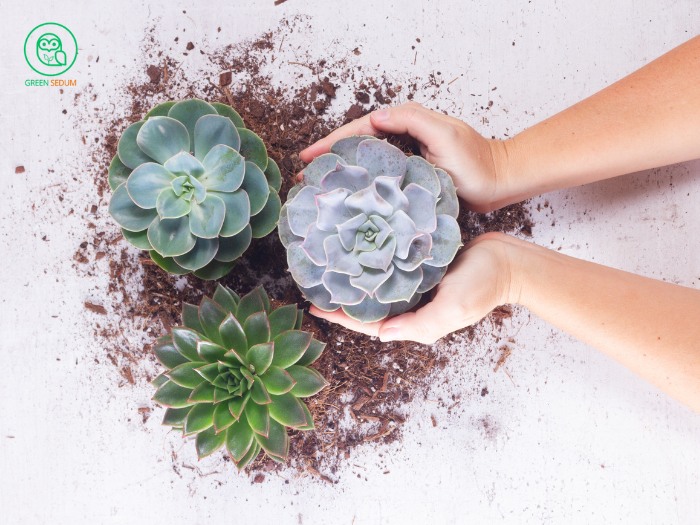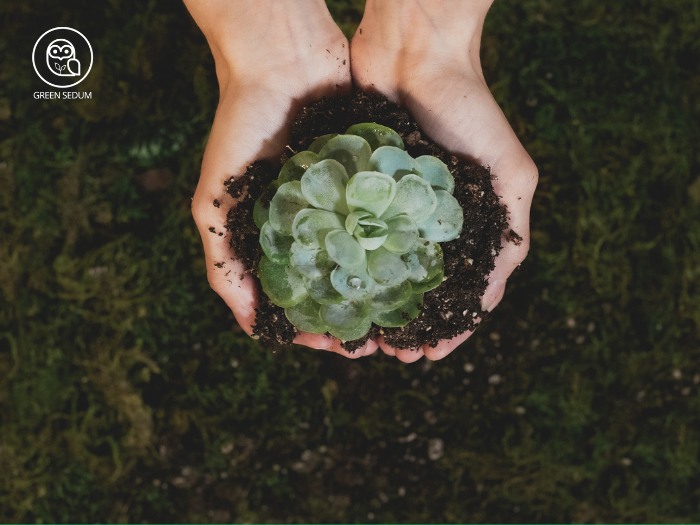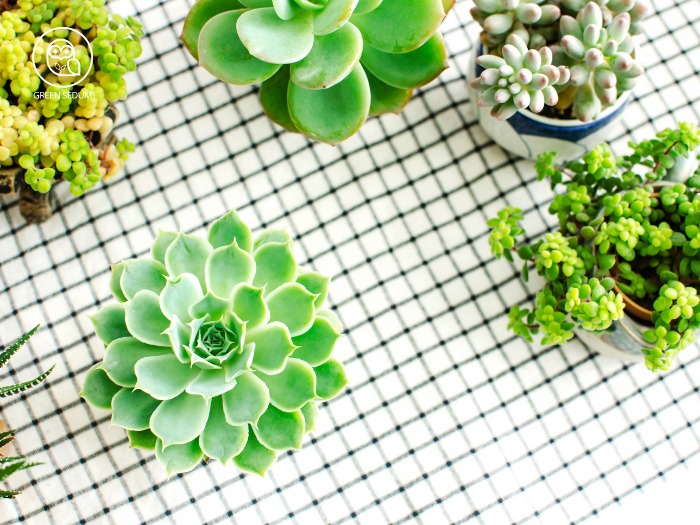Here, there are many like-minded individuals sharing the passion of Green Sedum, all enthralled by the diverse array of succulents with their vibrant colors and species. We all aspire to create our own little oasis of succulents to enjoy every day, perhaps accompanied by a cup of tea or coffee, savoring those moments of relaxation.
However, cultivating and caring for succulents can prove to be quite a challenge for beginners. So, let’s join Green Sedum in unraveling the answers to all our questions, from how to plant succulents when newly acquired, to nurturing them through the full spectrum of weather conditions. Keep reading to explore further!
>>>Explore this topic : What is a Succulent? Understanding Their Unique Characteristics
1. Confessions of Planting Succulents
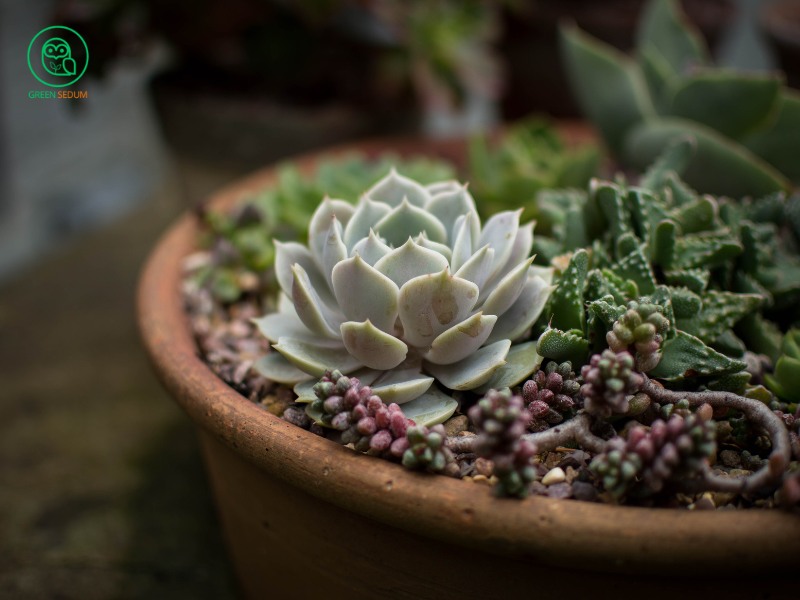
Driven by a passion for gardening, especially succulent plants planting, I began my journey some time ago. It hasn’t been without its challenges. At first, my approach to plant succulents was basic—using regular soil and watering every two days. Yet, after a week, my succulents perished.
I then searched the internet for guidance on how to plant succulents, but most resources only highlighted how easy succulents are to grow, not the difficulties beginners face. Fortunately, I worked at a horticultural company and learned from experts. Now, I own over 60 pots of succulents.
Growing succulents isn’t as easy as many assume. There is a need for practical knowledge on how to plant a succulent and care for them to help beginners avoid mistakes. Follow along as I share methods on how to pot succulents, how to plant succulents in pots, and how to grow succulent plants successfully.
2. Unveiling the Origins of Succulents
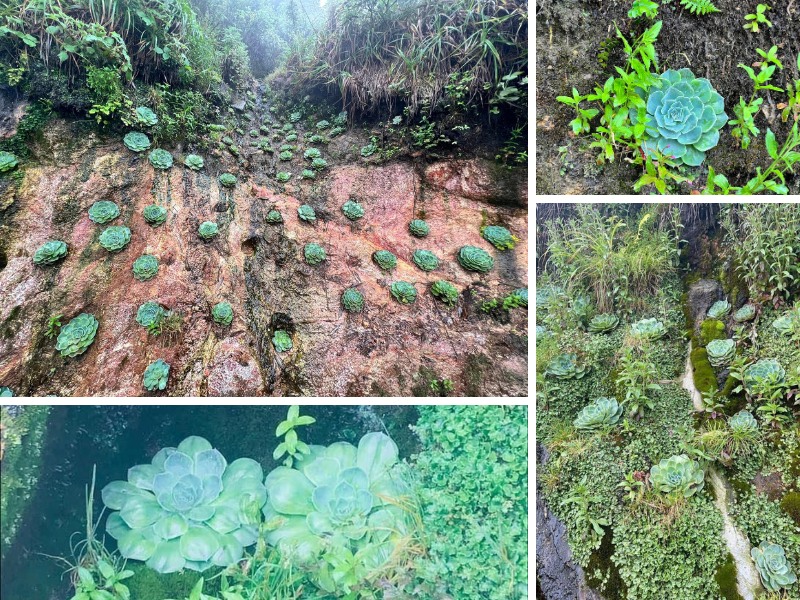
Succulent plants have thick, fleshy leaves that store water, enabling them to withstand dry conditions. They thrive in arid regions like deserts and tropical dry forests but can also grow in humid climates. Succulents originate from Africa, America, Central and South America, Asia, and Europe. Common species belong to the Crassulaceae, Aizoaceae, and Cactaceae families.
Succulents have become popular in ornamental gardening and interior decoration, often grown in pots, gardens, and even aquariums. Their diverse shapes, sizes, and colors make them a favorite for enhancing living and working spaces.
3. How to Choose Succulents
3.1. Which Types are Best for Beginners?
When starting with succulent plants, selecting the right varieties is crucial. For beginners, it’s best to plant succulents that are easy to grow and require minimal care. Ideal choices include Ghost Plant (Graptopetalum paraguayense), Graptopetalum mendozae, Echeveria ‘Lola’, Haworthia attenuata, Sedum adolphi ‘Firestorm’, Sedum burrito (Burro’s Tail), Graptopetalum superbum, and Echeveria ‘Crinoline Ruffles’. These succulent plants are hardy, disease-resistant, and perfect for new gardeners.
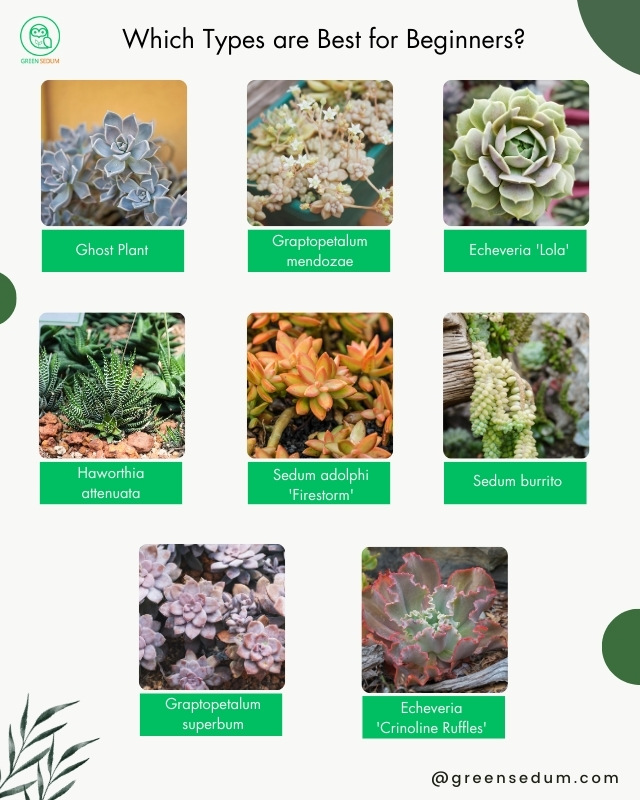
Avoid starting with varieties like Sempervivum Tectorum (Houseleek), which can be prone to losing color, stem rot, and spreading leaves, making them challenging for beginners. Start with easy-to-grow succulents to ensure a successful and enjoyable gardening experience.
3.2. How to Select the Right Succulent
When choosing succulents to plant, keep a few important factors in mind to ensure your plants are healthy and easy to care for:
- Color and Freshness: Pay attention to the color of the plant. Is it vibrant and fresh? The color of the leaves will be more striking as the plant grows. Choose succulents with bright and vivid leaf colors to enhance the attractiveness of your garden.
- Shape and Form: Check the shape of the plant. Succulents should have a balanced and upright form, not long, spindly, or leaning. This will help them grow strong and look more appealing in your garden.
- Leaf Condition: Inspect the leaves carefully. Avoid plants with soft, mushy leaves, which often indicate poor care or unsuitable environmental conditions. Opt for succulents with firm, robust leaves that show no signs of weakness.
- Soil and Medium: Look at the growing medium of the plant. If possible, select succulents that have been planted in perlite or pumice. This indicates that the plant has been well-cared for and is better adapted to tropical environments.
- Plant Age: Notice if the plant has an established stem, indicating it has gone through a long development process. Mature plants are generally healthier and easier to grow. Choose older, well-established succulents for a better chance of successful care.
By following these tips, you can ensure that the succulents you choose will thrive in your garden, providing beauty and satisfaction in your gardening endeavors.
>>> Read more:
- How to Care for Succulents: Essential Tips for Healthy Plants
- How Often to Water Succulents: Essential Tips for Every Season
4. Planting Water-Loving Succulents under Rain and Sun
4.1. Habitat
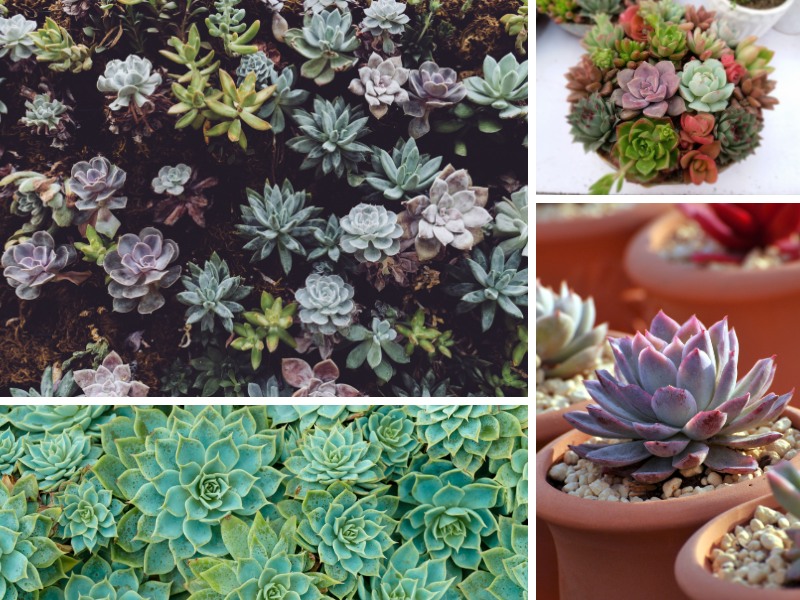
The key to successfully cultivating water-loving succulents is to create an environment that closely mimics their natural habitat (at least 70%). Succulents thrive in sunlight, so it’s best to employ OUTDOOR PLANTING METHODS and avoid indoor cultivation.
When I first ventured into succulent gardening, I experimented with growing them in my office. However, within just 5 days, the plants became weak and withered away.
=> Despite efforts to acclimate succulents to indoor conditions by exposing them to sunlight every 2-3 days, they still struggled. This is because succulents dislike frequent changes and prefer stability. Constantly shifting between indoor and outdoor environments can shock the plants.
Imagine living in San Diego one day, then relocating to San Francisco the next, and continuing this pattern. You’d feel exhausted and uncomfortable due to the sudden temperature fluctuations, right? This principle applies to our water-loving succulents as well.
4.2. Blending Growing Medium for Succulents
A quick reminder on succulent growing mediums:
Ever wondered if succulents can thrive in regular soil? Like in nature, succulents grow in loamy soil, right?
However,
You might already know that natural soils and rocks tend to be well-draining and airy, allowing for quick drying. This makes it easier for succulents to thrive. Don’t be mistaken and use loamy soil or garden soil for succulents! Loamy soil contains more clay and organic matter, retains water, and can lead to waterlogging for succulents.
Returning to the main issue, how to blend a suitable growing medium for hot climates? Let’s explore the blending formula below.
Method 1: DIY Blending (accessible ingredients, cost-effective, manual processing)
When blending a growing medium for succulents, ensure you have the following factors:
“AIRYNESS + POROSITY + MOISTURE RETENTION + NUTRIENT SUPPLY”
You can consider the following blending ratios:
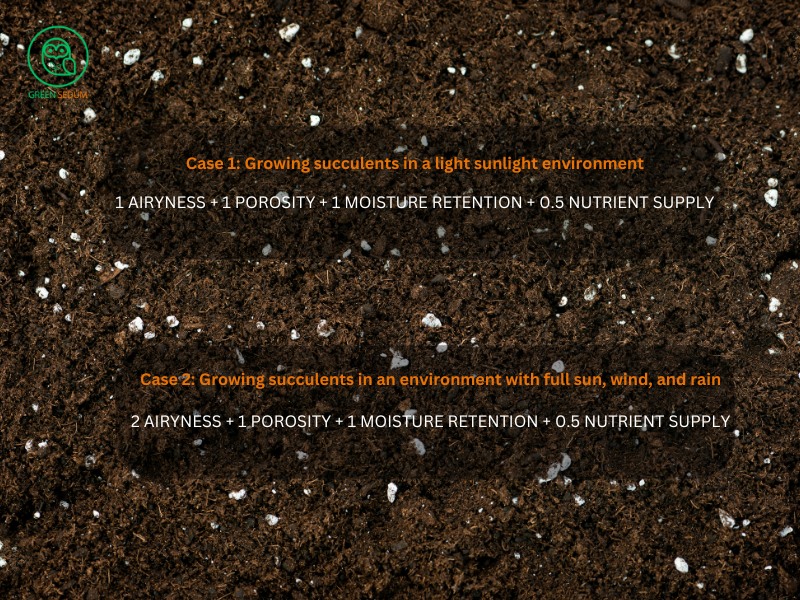
Blending Growing Medium for Succulents
During the process of blending a growing medium for succulents, you’ll need to utilize the following component ingredients:
Airiness:
- Akadama
- Masato
- Pumice
- Tuff
- Coral rock
- Baked clay granules (from Vietnam)
- Charcoal (please pre-treat before use)
Porosity:
- Perlite
- Whole grain rice husk
Moisture retention:
- Vermiculite
- Peat moss
- Whole grain rice husk
- Coconut coir
Nutrient supply:
- Manure
- Slow-release fertilizer
- Cinnamon fern compost
- Organic compost (properly decomposed)
- By combining these components, you can create an ideal environment for succulents, ensuring robust and healthy growth.
Tips for Blending Growing Medium for Succulents
Here are some things to keep in mind:
You can use each component as a separate ingredient instead of mixing them all together. For example, you can use 1 part charcoal + 1 part perlite + 1 part coconut coir + 0.5 part cinnamon fern compost.
Out of the 4 components, the nutrient component is not mandatory. Succulents naturally thrive on rocky surfaces without needing additional nutrients. If supplementation is desired, use sparingly, as too much fertilizer can cause overheating, shock, and death to the plants.
Adding a little Trichoderma powder can help prevent the growth of harmful fungi.
The pH level of the growing medium is also important. Succulents prefer slightly acidic growing mediums.
Each person may have a different blending formula, suitable for their specific growing environment and plant placement. Therefore, the growing medium guidelines found online are just a reference point; you’ll need to adjust them to fit your specific conditions.
Now, let’s start blending the growing medium to implement succulent cultivation!
Method 2: Purchasing Pre-Blended Growing Medium for Succulents
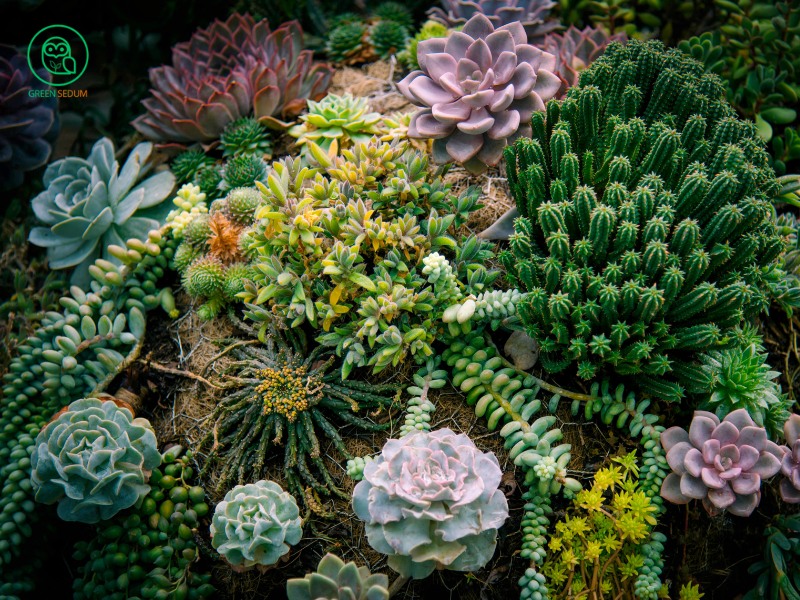
If you want to save time and ensure cleanliness, you can purchase pre-blended growing mediums available on the market for succulents. However, first, check if they contain all the necessary components. Some products like Soil Mix’s succulent soil or Namix Succulent Mix typically provide all the essential ingredients such as coconut coir, perlite, pumice, and cinnamon fern compost.
However, if you want to grow succulents under rain without worrying about waterlogging, you may consider blending additional components like airy and porous materials into the growing medium.
4.3. Planting Succulents After Purchase
Once you’ve selected the growing medium and bought your new succulent, there are a few final steps before completing a potted succulent arrangement.
Avoid planting your succulent immediately without addressing the old growing medium. Often when you purchase a new plant, the old growing medium may still contain old soil, and the roots may be congested and unable to absorb nutrients, leading to gradual weakening of the plant.
Remove the old growing medium & trim roots
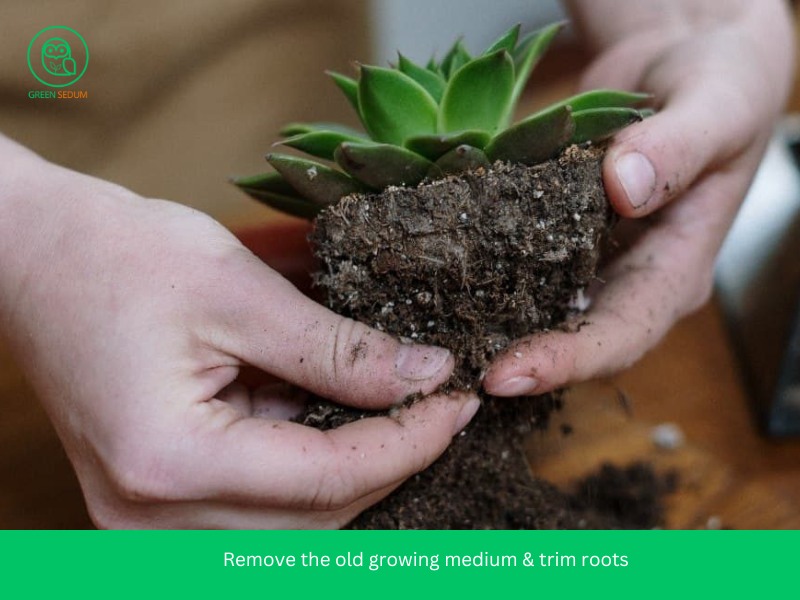
First, flip the pot containing the succulent and remove all the old soil. Gently separate any old coconut coir clinging to the roots.
Use clean scissors or a knife to trim away long and secondary roots. Keep only about 1-2cm of the main roots and remove any wilted leaves due to heat shock.
Then, place the succulent in a dry, cool place for about a week, avoiding direct sunlight. You can use a basket with holes or a plastic pot to hold the plant, allowing the roots to hang downwards.
Choosing the pot
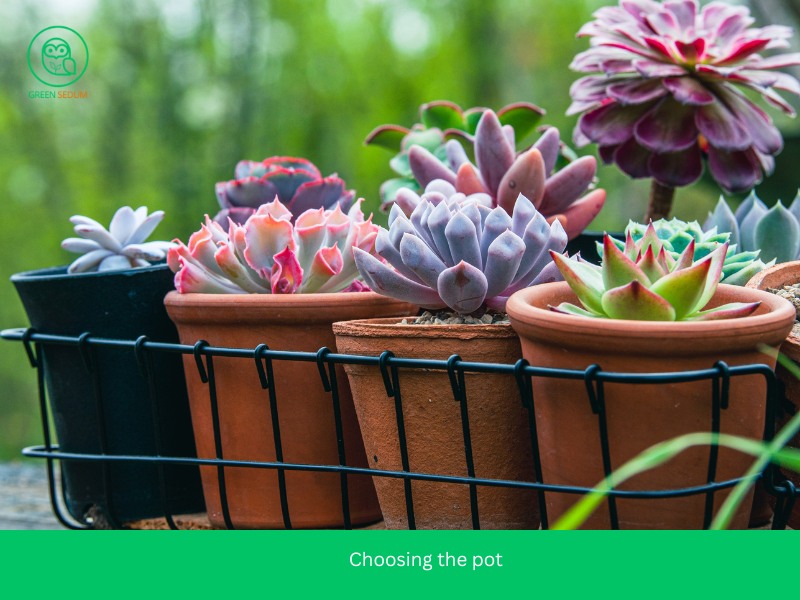
Among various types of pots such as cement, plastic, ceramic, and wood, I recommend that those growing succulents under rainfall choose a TERRACOTTA pot.
This type of pot has better drainage compared to others, is reasonably weighted, has a warm color, simple design, and high aesthetic value. Note that the pot should already have drainage holes at the bottom.
Next step: Planting the succulent
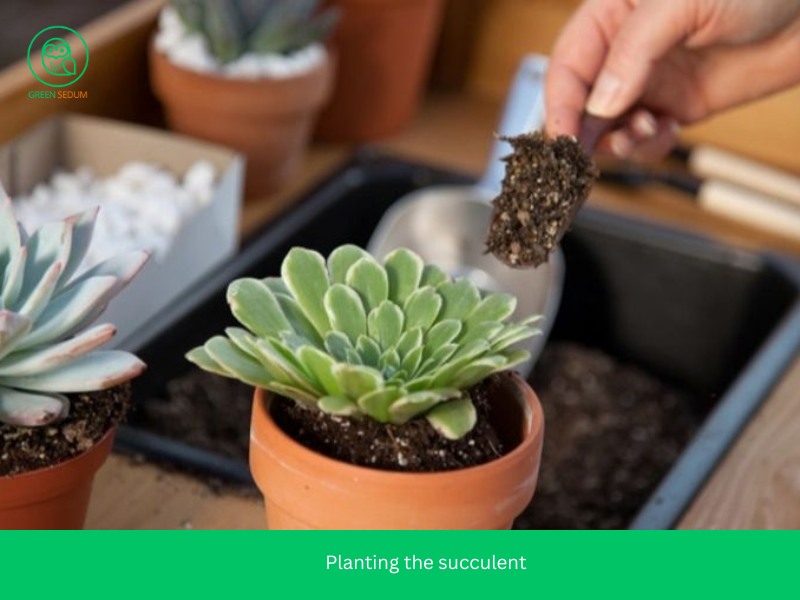
After about a week, the cuts on the roots should have dried, and new roots may begin to grow. You can now place the growing medium into the pot and begin the planting process.
The bottom of the pot is covered with a layer of large charcoal or baked clay granules, while the top layer consists of the pre-blended growing medium.
- Create a small hole in the middle of the pot and gently place the succulent inside. Use your fingers to lightly tap the sides of the pot to cover the roots with the growing medium. Do not compact the growing medium.
- Place the pot in a cool place and only water it the next day. Watering immediately after planting can lead to infection.
- After keeping the plant in shade for 7 days, gradually expose it to sunlight (about 4 hours a day), then slowly transition it to a location with full sunlight throughout the day.
4.4. Caring for Succulents After Planting
Sunlight and Color
To achieve the best leaf color for your succulents, you need to grow them with ample exposure to sunlight and natural weather conditions. Succulents kept in the shade or indoors typically do not display their most vibrant colors. Bright and vivid hues develop only when the plants receive adequate sunlight and the ideal temperature conditions.
In California, the rainiest month is August, which can cause succulents to lose some of their color. This is completely normal. However, your succulents will look their best during the sunny, less rainy seasons of the year.
Controlling Watering and Pot Care
Many beginners tend to overwater succulents, watering them frequently. However, remember that succulents are plants that dislike being overwatered. Excess water in the pot can lead to waterlogging, affecting the plant’s health.
Furthermore, avoid frequently moving the plant pot or placing it in locations with significant environmental and positional changes. This can shock the plant.
Let the plant grow naturally, checking its condition every three days.
Removing Old Leaves
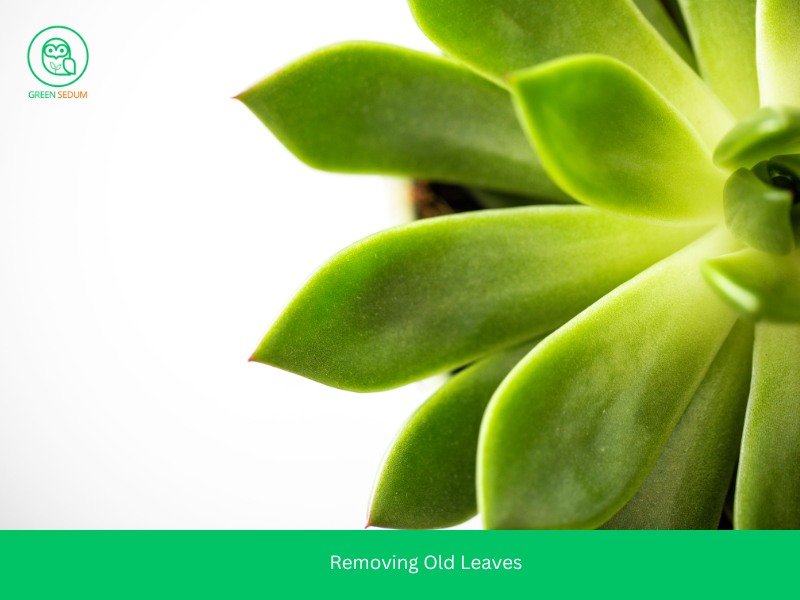
Old, wilted, wrinkled, or soft leaves should be promptly removed from the plant. These weak leaves can hinder the plant’s growth and attract harmful insects such as mealybugs, beetles, and spider mites.
Fertilizing Time
For succulents, there’s no need to fertilize excessively. Just a small amount of fertilizer every six months is sufficient. Organic compost and compressed cinnamon fern fertilizer pellets are good choices.
Winter Care for Succulents
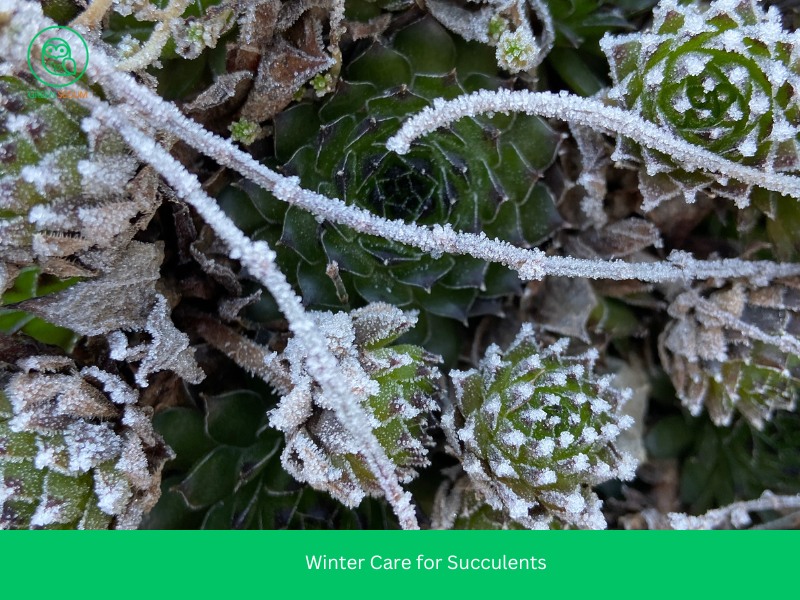
Succulents are known for their drought tolerance and dislike of overwatering. However, winter care for succulents requires attention to the type of succulent you have.
- Hardy Succulents: Varieties like sedum, euphorbias, and sempervivum can withstand very cold temperatures, down to -20ºF (-29ºC). These are ideal for outdoor planting in winter. When purchasing, always check the label to ensure they are suitable for your area’s temperatures.
- Tender Succulents: Varieties like aloe cannot tolerate freezing temperatures. They need to be brought indoors, where the temperature is around 50ºF (10ºC), or kept outdoors in regions where temperatures never drop below freezing. Even a light frost can damage their leaves, so if kept outside, they need frost protection.
Ensuring the appropriate conditions for each type of succulent will help them thrive through the winter.
>>> See related content: How to Propagate Succulents: A Step-by-Step Guide for Beginners
5. Conclusion
We’ve covered the essentials of how to plant succulents, from the initial purchase to growing them outdoors. Here are key points to remember:
- Water sparingly
- Use a well-draining, airy, and low-nutrient soil mix
- Grow outdoors whenever possible
- Avoid excessive handling
Thank you for following along to the end of this guide. If you have any comments or suggestions, feel free to email or share them in the comments section below. If you found this article helpful, please save it or share it with others interested in succulent plants planting.
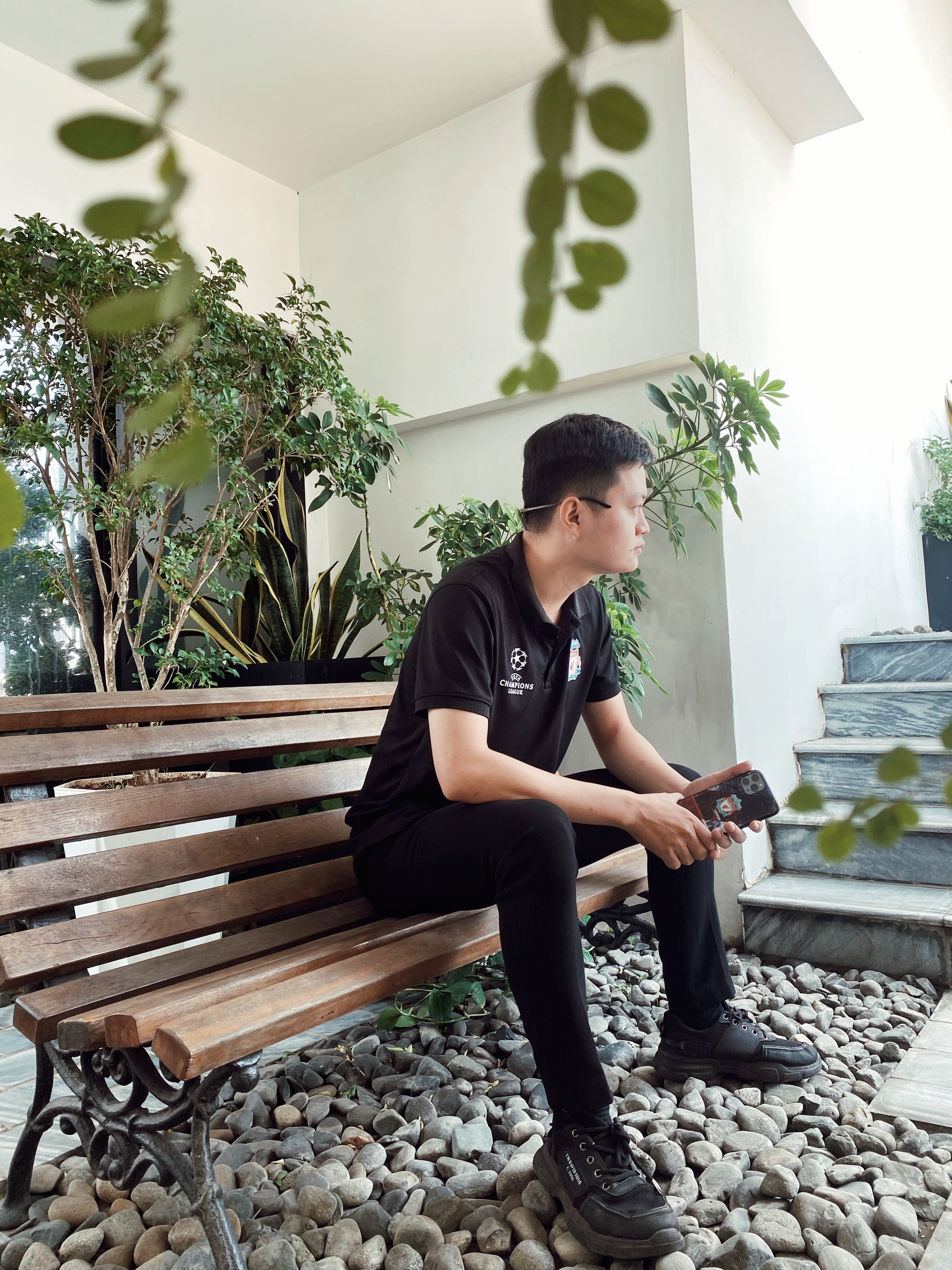
I’m Will Bernan, a gardening enthusiast with over 9 years of experience in succulents, indoor plants, and sustainable living. I also manage SEO for eco-friendly textile brands, promoting fabrics like bamboo and organic cotton.

